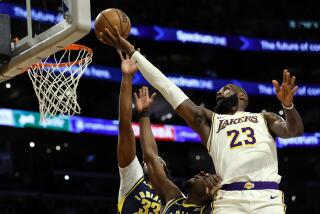SUNNY DAYS AHEAD?
- Share via
PHOENIX — A funny thing happened on the way to saving the game.
There were a lot of things that happened to the innovative Phoenix Suns’ coach, Mike D’Antoni, whose career before this season gave little promise of what was to come.
He lasted 50 games in his first job in Denver, losing 36. He waited five years for his next chance, which arrived last season when the Suns made him their interim coach for the last 61 games, of which he lost 41.
In a daring move, D’Antoni went to a small lineup this season with 6-foot-8 1/2 -- his actual height, as measured at the Chicago pre-draft camp -- Amare Stoudemire at center and wound up with the highest-scoring team in 10 seasons.
The Suns went from No. 13 in the West to No. 1 in the NBA in what became a season-long tribute to D’Antoni for rescuing the game from mud wrestling. Indiana Coach Rick Carlisle called it “one of the unique coaching jobs this league has seen in decades.” Denver’s George Karl said, “They’ve gotten most of the league going, ‘How do you stop this?’ and some of the league saying, ‘Can we play like this?’ ”
Suddenly, the Suns’ future is so bright, they have to wear shades. What could go wrong now?
“If we bomb out in the playoffs,” D’Antoni said, laughing, “it goes right back to what it was.”
In that case, it will have been fun while it lasted. At 110.4 points a game, the Suns are the highest-scoring NBA team since Shaquille O’Neal’s Orlando Magic averaged 110.9 in 1994-95.
Five other teams averaged more than 100 points this season -- Sacramento, Dallas, Miami, Boston, Washington -- with officials instructed to call the games tighter. Nevertheless, the old way, featuring muscle and defense, may be hard to displace.
It takes a lot of good players to do it the Suns’ way but depth is hard to come by in the salary-cap era. For fans hoping offense is coming back into fashion, this is the time and this is the team.
D’Antoni first tried this trick in his coaching debut with Philips Milan in the Italian league when he moved power forward Antonio Davis to center and began outscoring everyone.
Then, as now, D’Antoni wasn’t out to save the game. He was worried about something closer to home.
“I’m about ready to get fired,” D’Antoni said. “My assistants are yelling at me and people are yelling, ‘It’s not going to work.’ And all of a sudden, we had the best team over there, by far.”
Skepticism dies hard. As soon as it became clear the Suns were creating a regular-season miracle with a 6-8 1/2 center and a 6-6 1/2 power forward, all they heard was, “Let’s see you do that in the playoffs.”
However, the Suns have something else going: No matter how they play, they’re good.
“I know some people think it’s not going to last but that’s because they don’t want it to last,” said San Antonio Coach Gregg Popovich, who has won two titles. “Those guys aren’t going to forget how to run and they’re not going to forget how to shoot.
“Can they win in the playoffs playing like that? I don’t see why not.”
Where Did All
the Scoring Go?
The league office was wondering the same thing.
The game slowed dramatically in the ‘90s. In the first of their six title runs in 1990-91, the Chicago Bulls averaged 110 points a game; in the last one in 1997-98, they averaged 96.7.
The league could never figure out why, or what to do about it. In 1994, the three-point line was moved in ... and scoring decreased further, from 101.5 to 101.4.
After two more annual declines, the line was moved back ... and scoring decreased again, from 96.9 to 95.6.
What was happening was that teams were holding the ball longer, taking fewer shots. They were also shooting more three-pointers, keeping two or three players spotted up on the arc, making it easy to get back against the fast break.
This was a lesson missed by, among others, Laker owner Jerry Buss, in this season’s attempt to return to Showtime. In the ‘80s, the Lakers rebounded, got the ball to Magic Johnson and came down two on one and three on two with James Worthy, Byron Scott or Michael Cooper finishing in highlight-reel style. These days, it’s more often two on two and three on three.
The league never stopped trying. This season, referees were told to call fouls closer. Despite fears this would turn games into free-throw marathons, it tended to open the floor for the up-tempo teams.
Coincidentally, the Suns signed Steve Nash away from Dallas and Quentin Richardson away from the Clippers. When Richardson said he would prefer to start, D’Antoni began thinking about going small, with Richardson at small forward, Shawn Marion at power forward and Stoudemire at center.
The result isn’t a classic running team like the Showtime Lakers of 1984-85, who tried 3.6 threes a game, shot 30% on them and made 90 all season. The Suns took 24.6 threes a game, shot 39% and shattered the NBA record by 61, making 796 of them.
Stoudemire and Marion can outrun any other center and power forward in the league. If the Suns don’t have a numerical advantage, they fan out to the arc and take the first open three-pointer. If they have to play half-court, they fan out to the arc and take the first open three-pointer.
“The pace is real quick and they have a point guard who pushes and deals as well as any,” said Orlando assistant Paul Westhead, who set the NCAA record for scoring, 112.5, at Loyola Marymount. “But Amare Stoudemire is the key.
“It’s different from what we did. They run their big man right down the middle of the floor and Stoudemire, he’s just scary. He runs right down the middle and you better defend him. And if you do defend him, the wings are left open. If you don’t defend him, he’s going to be tomahawking on you.”
Suns Set, Suns Rise
Like the mythical Phoenix, the Suns have made a practice of rising from the ashes, from the drug scandals of the ‘80s and the post-Charles Barkley recession of the ‘90s and now after the disastrous 2001 Jason Kidd-for-Stephon Marbury trade.
They fell to 29-53 last season, melting themselves by sending Marbury to the New York Knicks to get the cap room they used to sign Nash last summer.
They still didn’t see this coming, expecting to start an orthodox lineup with Jake Voskuhl at center. D’Antoni was thinking of going small but one thing held him back: fear.
“You know, we talked about it and I was afraid,” he said. “You know, because everybody said it wouldn’t work....
“I convinced Amare to play [center] and Shawn to play [power forward], telling them if it didn’t work, we’d go back to the traditional way. So they had their thoughts or their fears about Amare matching up with Shaq or Yao Ming.
“But you know, when we started off so quick -- first game, everybody’s dunking and running and we’re up 20 and they’re going, ‘Well you know this is not too bad.’
“It just kept snowballing. It kept getting a little bit better.”
The Suns started the season 31-4 before losing six in a row, with Nash sitting out three of those because of back spasms and playing 11 minutes in a fourth.
Without Nash this season, the Suns were 2-5. With him, they were 60-15. They posted the league’s best road record, 31-10, and were an amazing 38-14 in the West, where six teams won 50 games and a seventh won 49. Home attendance is up 1,000 a game over last season’s padded figures. Sellouts are up from six to 26.
Stoudemire and Marion are exceptional athletes. Joe Johnson can play either guard spot at 6-8 and 240 pounds. Richardson is a powerhouse at 6-4 1/2 , 230.
Then there’s Nash, who’s not a great athlete but plays like one, living on the edge with one daring drive to the basket after another, running the game’s hottest offense like a jockey guiding a thoroughbred.
“I think this is the funnest way to play,” Nash said. “I think this is the way the game was meant to be played.”
These days, if you’re a Sun, someone on the other team comes up and says how wonderful it must be to be you. And then you run up 110 on his team.
Richardson, who began looking around when the Clippers put him on hold to court Kobe Bryant, has shot 7.9 threes a game this season, more than twice the average of the entire 1984-85 Laker team.
“Man, it’s the most fun I’ve had since I was playing AAU basketball, you know what I’m saying?” Richardson said. “Just being on a team with a lot of great players. You know, we’re all good guys. That’s what it makes it so fun.”
The fun part just ended. Now to see where this really leads.
“We’re going to score between 100-120 points so we don’t have to be great defensively,” D’Antoni said. “We have to be pretty good.... But we can get better. I think it’s in our court. Sometimes some team might say, ‘We have to score 150.’ Well, they can’t. They don’t have the players. We have the players.”
*
(BEGIN TEXT OF INFOBOX)
Rapid Fire
Phoenix ranked first in points per game, second in field-goal percentage and first in three-pointers made and attempted during the regular season:
POINTS PER GAME
*--* Team Own Opp. PHOENIX 110.4 103.3 Sacramento 103.7 101.6 Dallas 102.5 96.8 Miami 101.5 95.0 Boston 101.3 100.4 Washington 100.5 100.8
*--*
FIELD-GOAL PERCENTAGE
*--* Team Own Opp. Miami 48.6 42.7 PHOENIX 47.7 44.5 Boston 46.8 44.4 Denver 45.9 44.7 Clippers 45.9 44.4 Minnesota 45.9 43.8 Sacramento 45.9 45.9
*--*
3-POINTERS MADE PER GAME
*--* Team Made Att. PHOENIX 9.7 24.6 Seattle 8.2 22.3 Toronto 8.0 20.6 Lakers 7.9 22.0 Golden State 7.6 21.6
*--*
More to Read
Go beyond the scoreboard
Get the latest on L.A.'s teams in the daily Sports Report newsletter.
You may occasionally receive promotional content from the Los Angeles Times.










